A Novel Flow Model of Strain Hardening and Softening for Use in Tensile Testing of a Cylindrical Specimen at Room Temperature
Abstract
:1. Introduction
2. Materials and Methods
3. Description of Strain Softening Using the Second Strain Hardening Parameter
4. Discussions and Conclusions
4.1. Discussions
4.2. Conclusions
Author Contributions
Funding
Institutional Review Board Statement
Informed Consent Statement
Data Availability Statement
Conflicts of Interest
References
- Liang, R.; Khan, A.S. A critical review of experimental results and constitutive models for BCC and FCC metals over a wide range of strain rates and temperatures. Int. J. Plast. 1999, 15, 963–980. [Google Scholar] [CrossRef]
- Tu, S.; Ren, X.; He, J.; Zhang, Z. Stress–strain curves of metallic materials and post-necking strain hardening characterization: A review. Fat. Fract. Eng. Mater. Struct. 2020, 43, 3–19. [Google Scholar] [CrossRef] [Green Version]
- Tvergaard, V.; Needleman, A. Analysis of the cup-cone fracture in a round tensile bar. Acta Metall. 1999, 132, 157–169. [Google Scholar] [CrossRef]
- Gelin, J.C.; Oudin, J.; Ravalard, Y.; Moisan, A. An improved finite element method for the analysis of damage and ductile fracture in cold forming processes. CIRP Ann. 1985, 34, 209–213. [Google Scholar] [CrossRef]
- Bridgman, P.W. Studies in Large Plastic Flow and Fracture; McGraw-Hill: New York, NY, USA, 1952. [Google Scholar]
- Joun, M.; Choi, S.I.S.; Eom, J.G.; Lee, M.C. Finite element analysis of tensile testing with emphasis on necking. Comput. Mater. Sci. 2007, 41, 63–69. [Google Scholar] [CrossRef]
- Zhang, K.S.; Li, Z.H. Numerical analysis of the stress-strain curve and fracture initiation for ductile material. Eng. Fract. Mech. 1994, 49, 235–241. [Google Scholar] [CrossRef]
- Cabezas, E.E.; Celentano, D.J. Experimental and numerical analysis of the tensile test using sheet specimens. Finite Elem. Anal. Des. 2004, 40, 555–575. [Google Scholar] [CrossRef] [Green Version]
- Mirone, G. A new model for the elastoplastic characterization and the stress–strain determination on the necking section of a tensile specimen. Int. J. Solids Struct. 2004, 41, 3545–3564. [Google Scholar] [CrossRef]
- Joun, M.S.; Eom, J.G.; Lee, M.C. A new method for acquiring true stress–strain curves over a large range of strains using a tensile test and finite element method. Mech. Mater. 2008, 40, 586–593. [Google Scholar] [CrossRef]
- Eom, J.G.; Son, Y.H.; Jeong, S.W.; Ahn, S.T.; Jang, S.M.; Yoon, D.J.; Joun, M.S. Effect of strain hardening capability on plastic deformation behaviors of material during metal forming. Mater. Des. 2014, 54, 1010–1018. [Google Scholar] [CrossRef]
- Gavrus, A.; Massoni, E.; Chenot, J.L. An inverse analysis using a finite element model for identification of rheological parameters. J. Mat. Proc. Tech. 1996, 60, 447–454. [Google Scholar] [CrossRef]
- Lin, Y.C.; Chen, X.M. A critical review of experimental results and constitutive descriptions for metals and alloys in hot working. Mater. Des. 2011, 32, 1733–1759. [Google Scholar] [CrossRef]
- Mahnken, R.; Stein, E. A unified approach for parameter identification of inelastic material models in the frame of the finite element method. Comput. Methods Appl. Mech. Eng. 1996, 136, 225–258. [Google Scholar] [CrossRef]
- Mahnken, R.; Stein, E. The parameter-identification for viscoplastic models via finite-element-methods and gradient- methods. Model. Simul. Mater. Sci. Eng. 1994, 2, 597. [Google Scholar] [CrossRef]
- Nayebi, A.; El Abdi, R.; Bartier, O.; Mauvoisin, G. New procedure to determine steel mechanical parameters from the spherical indentation technique. Mech. Mater. 2002, 34, 243–254. [Google Scholar] [CrossRef]
- Campitelli, E.N.; Bonadé, P.R.; Hoffelner, W.; Victoria, M. Assessment of the constitutive properties from small ball punch test: Experiment and modeling. J. Nucl. Mater. 2004, 335, 366–378. [Google Scholar] [CrossRef]
- Springmann, M.; Kuna, M. Identification of material parameters of the Gurson–Tvergaard–Needleman model by combined experimental and numerical techniques. Comput. Mater. Sci. 2005, 32, 501–509. [Google Scholar] [CrossRef]
- Isselin, J.; Iost, A.; Golek, J.; Najjar, D.; Bigerelle, M. Assessment of the constitutive law by inverse methodology: Small punch test and hardness. J. Nucl. Mater. 2006, 35, 97–106. [Google Scholar] [CrossRef] [Green Version]
- Bressan, J.D.; Unfer, R.K. Construction and validation tests of a torsion test machine. J. Mater. Process. Technol. 2006, 179, 23–29. [Google Scholar] [CrossRef]
- Koc, P.; Štok, B. Computer-aided identification of the yield curve of a sheet metal after onset of necking. Comput. Mater. Sci. 2004, 31, 155–168. [Google Scholar] [CrossRef]
- Kim, J.H.; Serpantié, A.; Barlat, F.; Pierron, F.; Lee, M.G. Characterization of the post-necking strain hardening behavior using the virtual fields method. Int. J. Solids Struct. 2013, 50, 3829–3842. [Google Scholar] [CrossRef] [Green Version]
- Kamaya, M.; Kawakubo, M. A procedure for determining the true stress–strain curve over a large range of strains using digital image correlation and finite element analysis. Mech. Mater. 2011, 43, 243–253. [Google Scholar] [CrossRef]
- Quanjin, M.; Rejab, M.R.; Halim, Q.; Merzuki, M.N.; Darus, M.A. Experimental investigation of the tensile test using digital image correlation (DIC) method. Mater. Todays Proc. 2020, 27, 757–763. [Google Scholar] [CrossRef]
- Barrett, T.J.; Knezevic, M. Modeling material behavior during continuous bending under tension for inferring the post-necking strain hardening response of ductile sheet metals: Application to DP 780 steel. Int. J. Mech. Sci. 2020, 174, 105508. [Google Scholar] [CrossRef]
- Kim, M.; Gu, B.; Hong, S. Determination of post-necking stress-strain relationship for zirconium low-oxidation based on actual cross-section measurements by DIC. J. Mech. Sci. Technol. 2020, 34, 4211–4217. [Google Scholar] [CrossRef]
- Kim, M.; Park, T.Y.; Hong, S. Experimental determination of the plastic deformation and fracture behavior of polypropylene composites under various strain rates. Poly. Test. 2021, 93, 107010. [Google Scholar] [CrossRef]
- Eom, J.G.; Chung, W.J.; Joun, M.S. Comparison of rigid-plastic and elastoplastic finite element predictions of a tensile test of cylindrical specimens. Key. Eng. Mater. 2014, 622, 611–616. [Google Scholar] [CrossRef]
- Eom, J.G.; Kim, M.C.; Lee, S.W.; Ryu, H.Y.; Joun, M.S. Evaluation of damage models by finite element prediction of fracture in cylindrical tensile test. J. Nanosci. Nanotechnol. 2014, 14, 8019–8023. [Google Scholar] [CrossRef] [PubMed]
- Ganharul, G.K.Q.; de Brangança Azevedo, N.; Donato, G.H.B. Methods for the experimental evaluation of true stress-strain curves after necking of conventional tensile specimens: Exploratory investigation and proposals. In Proceedings of the ASME 2012 Pressure Vessels and Piping Conference, Toronto, ON, Canada, 15–19 July 2012; Volume 55058, pp. 163–172. [Google Scholar] [CrossRef]
- Donato, G.H.B.; Ganharul, G.K.Q. Methodology for the experimental assessment of true stress-strain curves after necking employing cylindrical tensile specimens: Experiments and parameters calibration. In Proceedings of the ASME 2013 Pressure Vessels and Piping Conference, Paris, France, 14–18 July 2013; p. 55706. [Google Scholar] [CrossRef]
- Zhu, F.; Bai, P.; Zhang, J.; Lei, D.; He, X. Measurement of true stress–strain curves and evolution of plastic zone of low carbon steel under uniaxial tension using digital image correlation. Opt. Lasers. Eng. 2015, 65, 81–88. [Google Scholar] [CrossRef]
- Majzoobi, G.H.; Fariba, F.; Pipelzadeh, M.K.; Hardy, S.J. A new approach for the correction of stress–strain curves after necking in metals. J. Strain. Anal. Eng. Des. 2015, 50, 125–137. [Google Scholar] [CrossRef]
- Wang, Y.D.; Xu, S.H.; Ren, S.B.; Wang, H. An experimental-numerical combined method to determine the true constitutive relation of tensile specimens after necking. Adv. Mater. Sci. Eng. 2016, 2016, 1–12. [Google Scholar] [CrossRef] [Green Version]
- Jeník, I.; Kubík, P.; Šebek, F.; Hůlka, J.; Petruška, J. Sequential simulation and neural network in the stress–strain curve identification over the large strains using tensile test. Arch. Appl. Mech. 2017, 87, 1077–1093. [Google Scholar] [CrossRef]
- Kweon, H.D.; Heo, E.J.; Lee, H.D.; Kim, J.W. A methodology for determining the true stress-strain curve of SA-508 low alloy steel from a tensile test with finite element analysis. J. Mech. Sci. Technol. 2018, 32, 3137–3143. [Google Scholar] [CrossRef]
- Paul, S.K.; Roy, S.; Sivaprasad, S.; Tarafder, S. A Simplified procedure to determine post-necking true stress–strain curve from uniaxial tensile test of round metallic specimen using DIC. J. Mater. Eng. Perform. 2018, 27, 4893–4899. [Google Scholar] [CrossRef]
- Mirone, G.; Verleysen, P.; Barbagallo, R. Tensile testing of metals: Relationship between macroscopic engineering data and hardening variables at the semi-local scale. Int. J. Mech. Sci. 2019, 150, 154–167. [Google Scholar] [CrossRef]
- Chen, J.; Guan, Z.; Ma, P.; Li, Z.; Gao, D. Experimental extrapolation of hardening curve for cylindrical specimens via pre-torsion tension tests. J. Strain. Anal. Eng. Des. 2020, 55, 20–30. [Google Scholar] [CrossRef]
- Ludwik, P. Elemente der Technologischen Mechanik; Springer: Berlin, Germany, 1909. [Google Scholar]
- Hollomon, J.H. Coordinate and amplify the knowledge. AIME Trans. 1945, 162, 268. [Google Scholar]
- Swift, H.W. Plastic instability under plane stress. J. Mech. Phys. Solids 1952, 1, 1–8. [Google Scholar] [CrossRef]
- Voce, E. The relationship between stress and strain for homogeneous deformation. J. Inst. Metals 1948, 74, 537–562. [Google Scholar]
- Byun, J.B.; Razali, M.K.; Lee, C.J.; Seo, I.D.; Chung, W.J.; Joun, M.S. Automatic multi-stage cold forging of an SUS304 ball-stud with a hexagonal hole at one end. Materials 2020, 13, 5300. [Google Scholar] [CrossRef] [PubMed]
- Li, J.; Yang, G.; Siebert, T.; Shi, M.; Yang, L. A method of the direct measurement of the true stress–strain curve over a large strain range using multi-camera digital image correlation. Opt. Lasers Eng. 2018, 107, 194–201. [Google Scholar] [CrossRef]
- Kudryashov, N.A.; Ryabov, P.N. Analytical and numerical solutions of the generalized dispersive Swift–Hohenberg equation. Appl. Math. Comput. 2016, 286, 171–177. [Google Scholar] [CrossRef]
- Hollomon, J.H. Tensile deformation. Aime Trans. 1945, 12, 1–22. [Google Scholar] [CrossRef]
- Considère, M. L’emploi du fer de l’acier dans les constructions. Memoire No 34 In. Ann. Ponts. Chaussées: Paris 1885, 9, 574. [Google Scholar]
- Joun, M.S.; Lee, M.C.; Eom, J.G. Intelligent metal-forming simulation. In Proceedings of the ASME 2011 International Manufacturing Science and Engineering Conference, Corvallis, OR, USA, 13–17 June 2011; Volume 1, pp. 161–168. [Google Scholar] [CrossRef]
- Husain, A.; Sehgal, D.K.; Pandey, R.K. An inverse finite element procedure for the determination of constitutive tensile behavior of materials using miniature specimen. Comput. Mater. Sci. 2004, 31, 84–92. [Google Scholar] [CrossRef]
- Gurson, A.L. Continuum theory of ductile rupture by void nucleation and growth: Part I: The yield criteria and flow rules for porous ductile media. J. Eng Mater. Technol.-Trans. ASME 1977, 99, 2–15. [Google Scholar] [CrossRef]
- Cockcroft, M.G.; Latham, D.J. Ductility and the workability of metals. J. Inst. Met. 1968, 96, 33–39. [Google Scholar]
- Brozzo, P.; Deluca, B.; Rendina, R. A new method for the prediction of formability limits in metal sheets. In Proceedings of the 7th Biennial Congress of the IDDRG, Amsterdam, The Netherlands, 9–13 October 1972; Volume 3, pp. 1–4. [Google Scholar]
- Oyane, M. Criteria of ductile fracture strain. Bull. JSME 1972, 15, 1507–1513. [Google Scholar] [CrossRef]
- Rice, J.R.; Tracey, D.M. On the ductile enlargement of voids in triaxial stress fields. J. Mech. Phys. Solids 1969, 17, 201–217. [Google Scholar] [CrossRef] [Green Version]
- Clift, S.E.; Hartley, P.; Sturgess, C.E.N.; Rowe, G.W. Fracture prediction in plastic deformation processes. Int. J. Mech. Sci. 1990, 32, 1–7. [Google Scholar] [CrossRef]
- Khelifa, M.; Oudjene, M.; Khennane, A. Fracture in sheet metal forming: Effect of ductile damage evolution. Comput. Struct. 2007, 85, 205–212. [Google Scholar] [CrossRef]
- Benzerga, A. Micromechanics of coalescence in ductile fracture. J. Mech. Phys. Solids. 2002, 50, 1331–1362. [Google Scholar] [CrossRef]
- Gelin, J.C. Modelling of damage in metal forming processes. J. Mate. Process. Technol. 1998, 24, 80–81. [Google Scholar] [CrossRef]
- Wierzbicki, T.; Bao, Y.; Lee, Y.W.; Bai, Y. Calibration and evaluation of seven fracture models. Int. J. Mech. Sci. 2005, 47, 719–743. [Google Scholar] [CrossRef]
- Chaouadi, R.; Meester, P.; Vandermeulen, W. Damage work as ductile fracture criterion. Int. J. Fract. 1994, 66, 155–164. [Google Scholar] [CrossRef]
- Lou, Y.; Huh, H. Extension of a shear-controlled ductile fracture model considering the stress triaxiality and the Lode parameter. Int. J. Solids Struct. 2013, 50, 447–455. [Google Scholar] [CrossRef] [Green Version]
- Zhu, Y.Y.; Cescotto, S.; Habraken, A.M. A fully coupled elastoplastic damage modeling and fracture criteria in metalforming processes. J. Mater. Process. Technol. 1992, 32, 197–204. [Google Scholar] [CrossRef]
- Gologanu, M.; Leblond, J.B.; Perrin, G.; Devaux, J. Theoretical models for void coalescence in porous ductile solids. I. Coalescence “in layers”. Int. J. Solids Struct. 2001, 38, 5581–5594. [Google Scholar] [CrossRef]
- Lestriez, P.; Saanouni, K.; Cherouat, J.F. Numerical prediction of ductile damage in metal forming processes including thermal effects. Int. J. Damage Mech. 2004, 13, 59–80. [Google Scholar] [CrossRef]
- Saanouni, K.; Mariage, J.F.; Cherouat, A.; Lestriez, P. Numerical prediction of discontinuous central bursting in axisymmetric forward extrusion by continuum damage mechanics. Comput. Struct. 2004, 82, 2309–2332. [Google Scholar] [CrossRef]
- Labergere, C.; Lestriez, P.; Saanouni, K.; Rassineux, A. Numerical simulation of bursting in extrusion process using finite viscoplasticity with ductile damage and thermal effects. Int. J. Mater. Form. 2009, 2, 89–92. [Google Scholar] [CrossRef]
- Farbaniec, L.; Couque, H.; Dirras, G. Size effects in micro-tensile testing of high purity polycrystalline nickel. Int. J. Eng. Sci. 2017, 119, 192–204. [Google Scholar] [CrossRef]
- Joun, M.S.; Lee, H.J.; Lim, S.G.; Lee, K.H.; Cho, G.S. Dynamic strain aging of an AISI 1025 steel coil and its relationship with macroscopic responses during the upsetting process. Int. J. Mech. Sci. 2021, 200, 106423. [Google Scholar] [CrossRef]
- Felix, R.; Hong, S. Evolution of Instantaneous r-values in the post-critical region and its implications on the deformation behavior. Int. J. Mech. Sci. 2021, 206, 106612. [Google Scholar] [CrossRef]
- Eom, J.G.; Byun, S.W.; Jeong, S.W.; Chung, W.J.; Joun, M.S. A new methodology for predicting brittle fracture of plastically deformable materials: Application to a cold shell nosing process. Materials 2021, 14, 1593. [Google Scholar] [CrossRef] [PubMed]
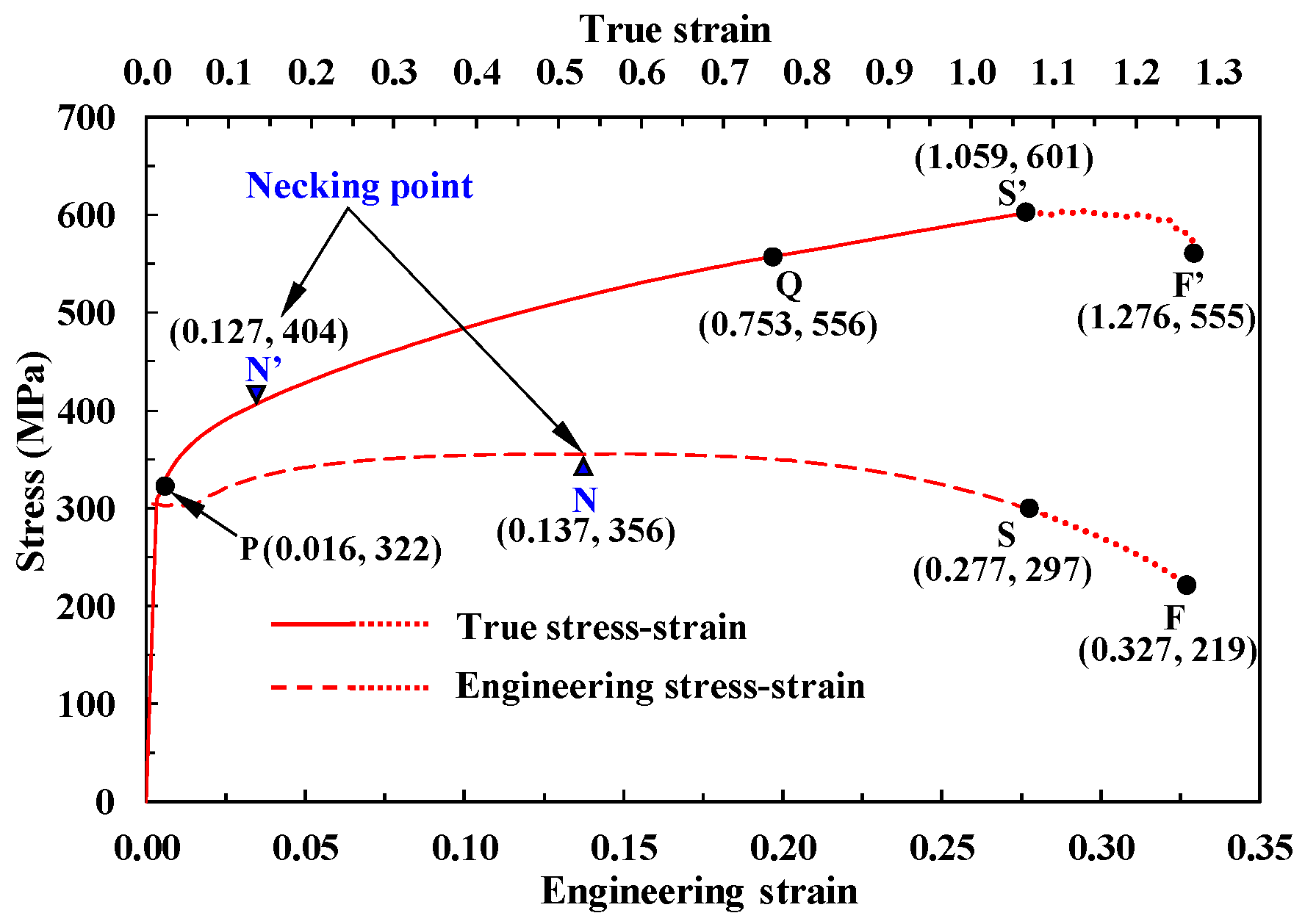
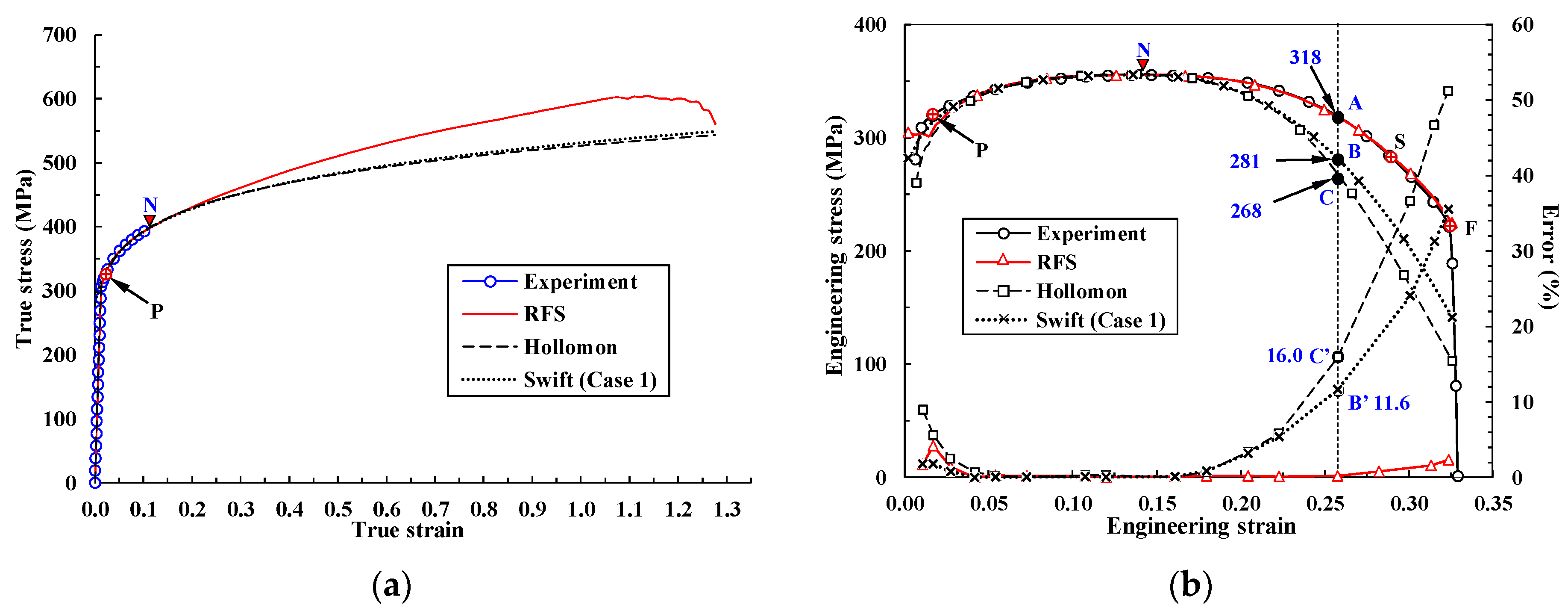
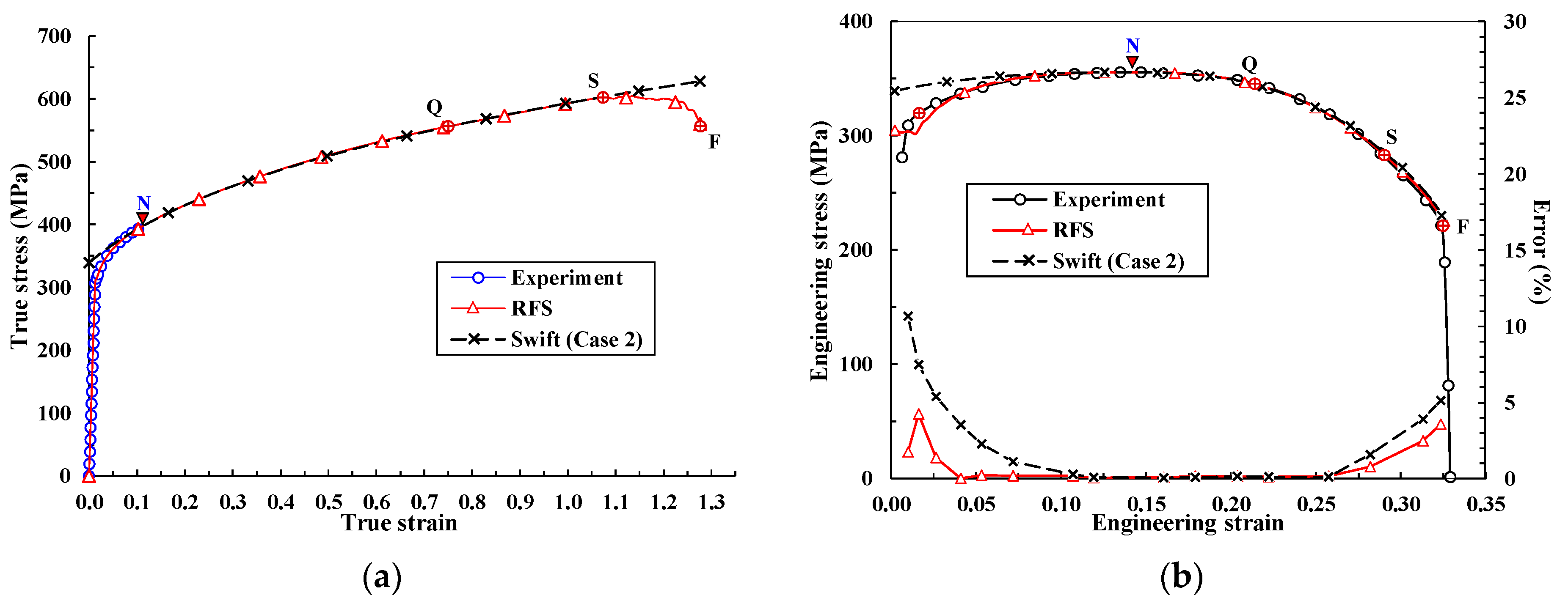
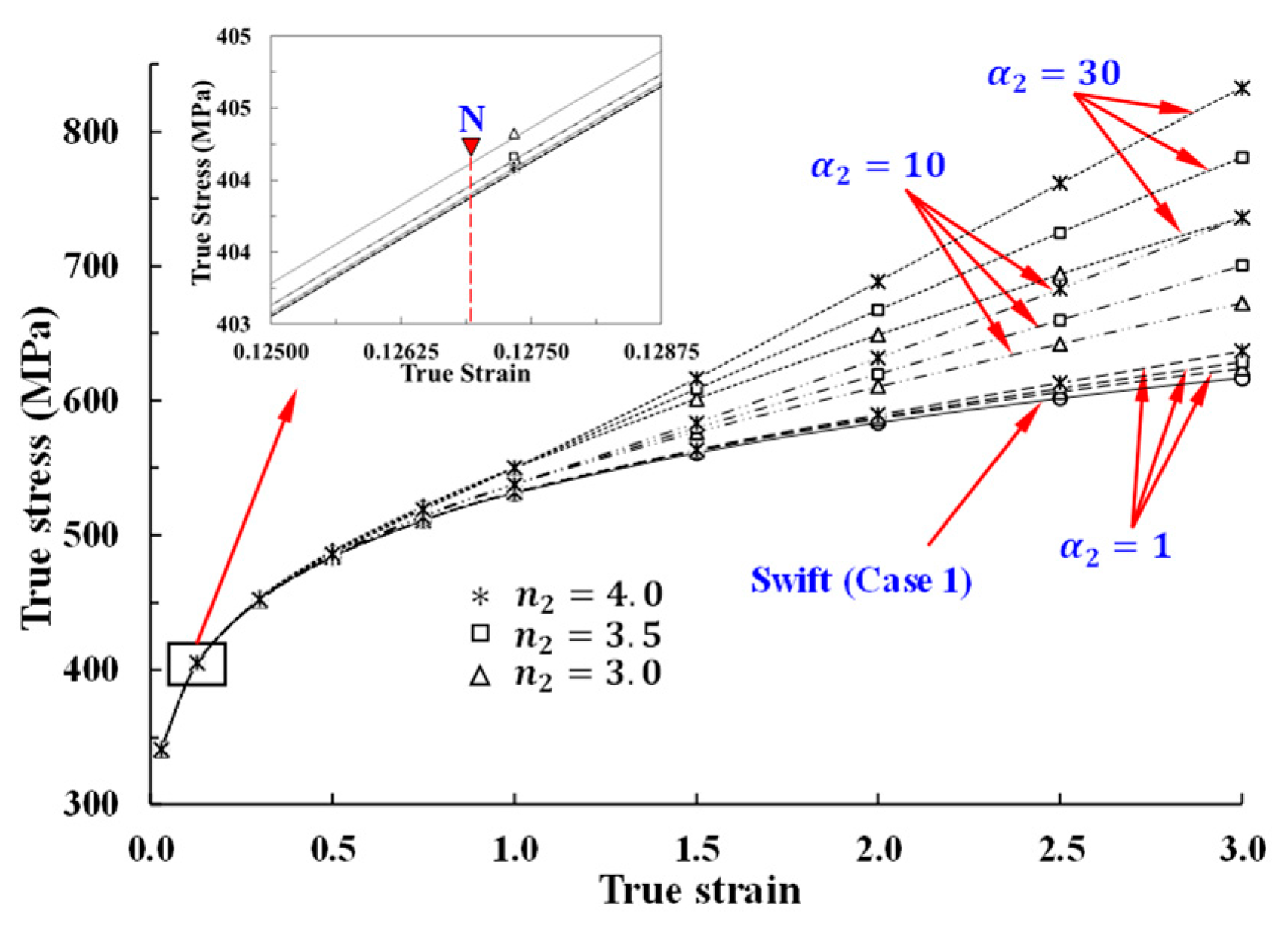

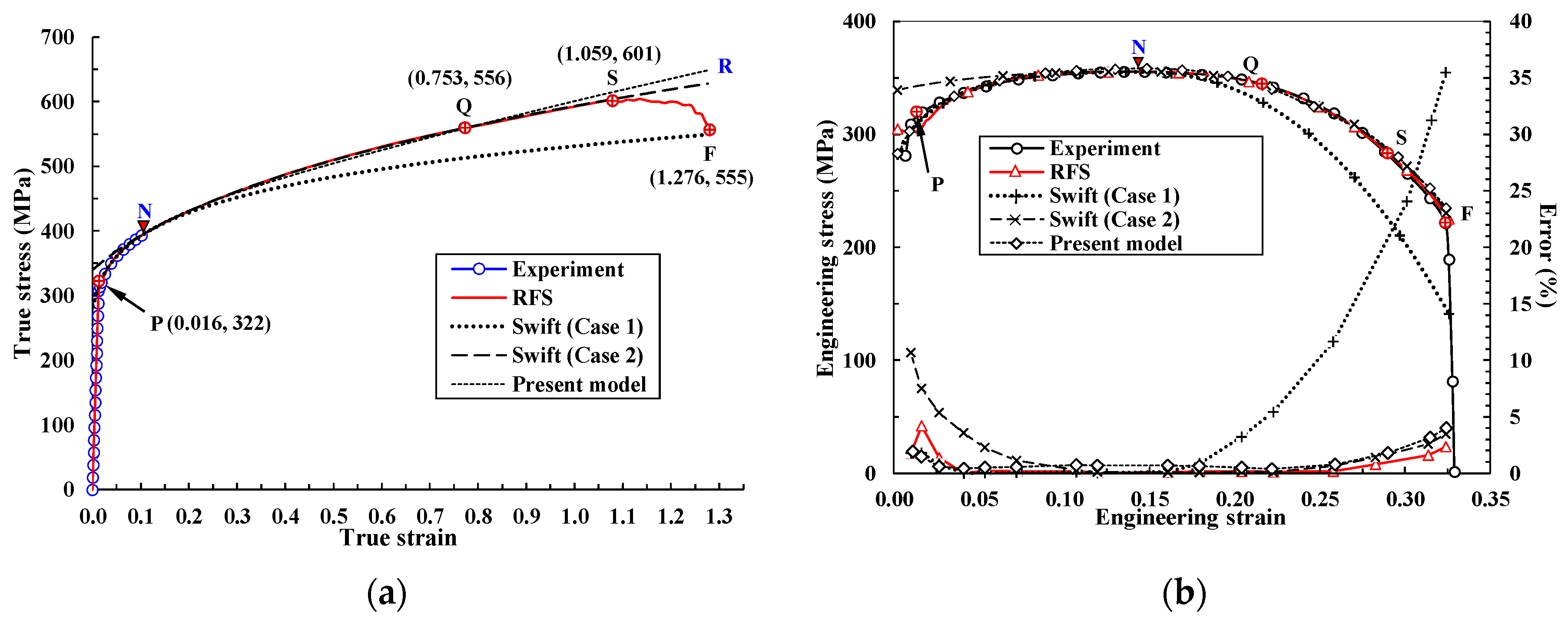
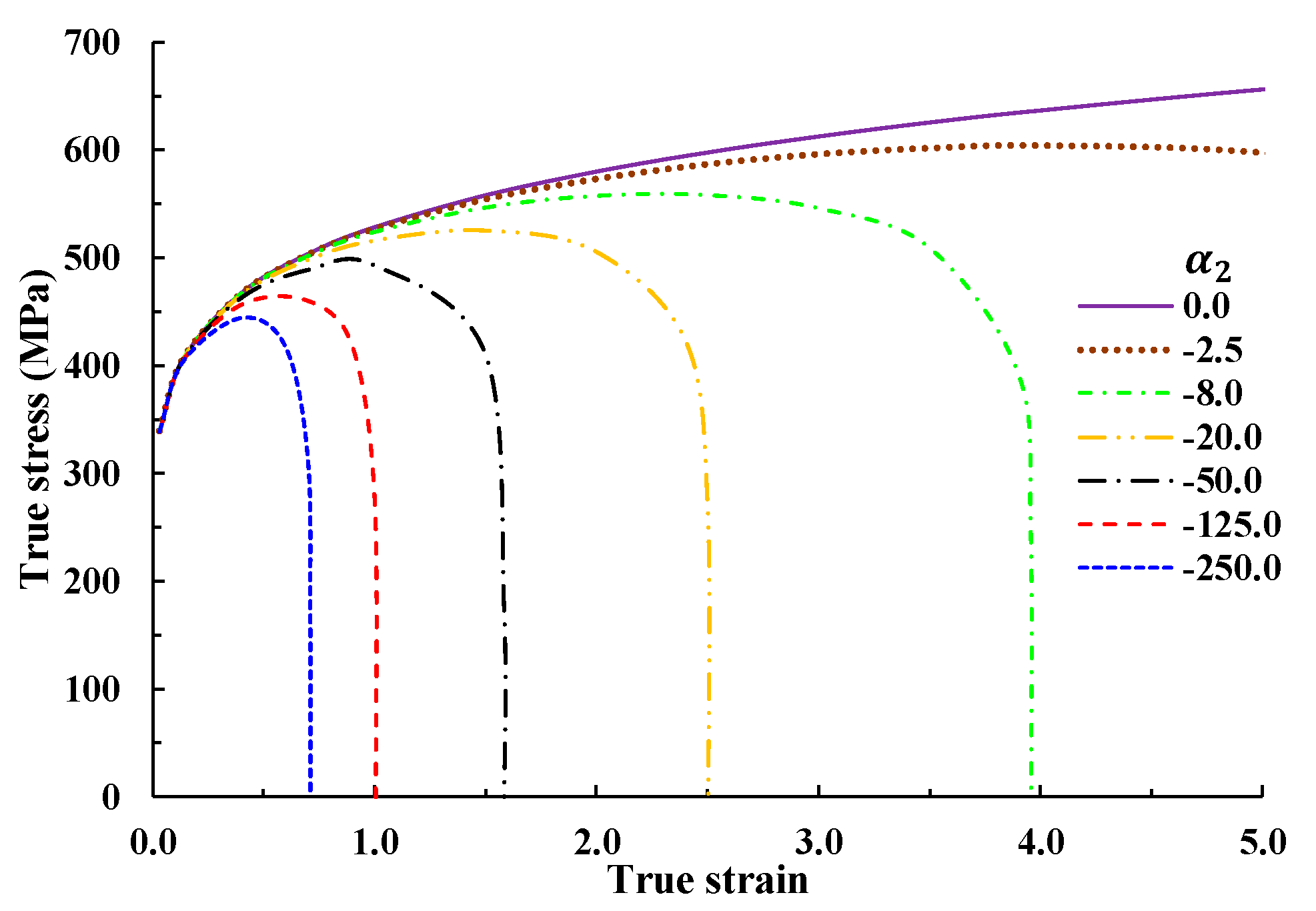


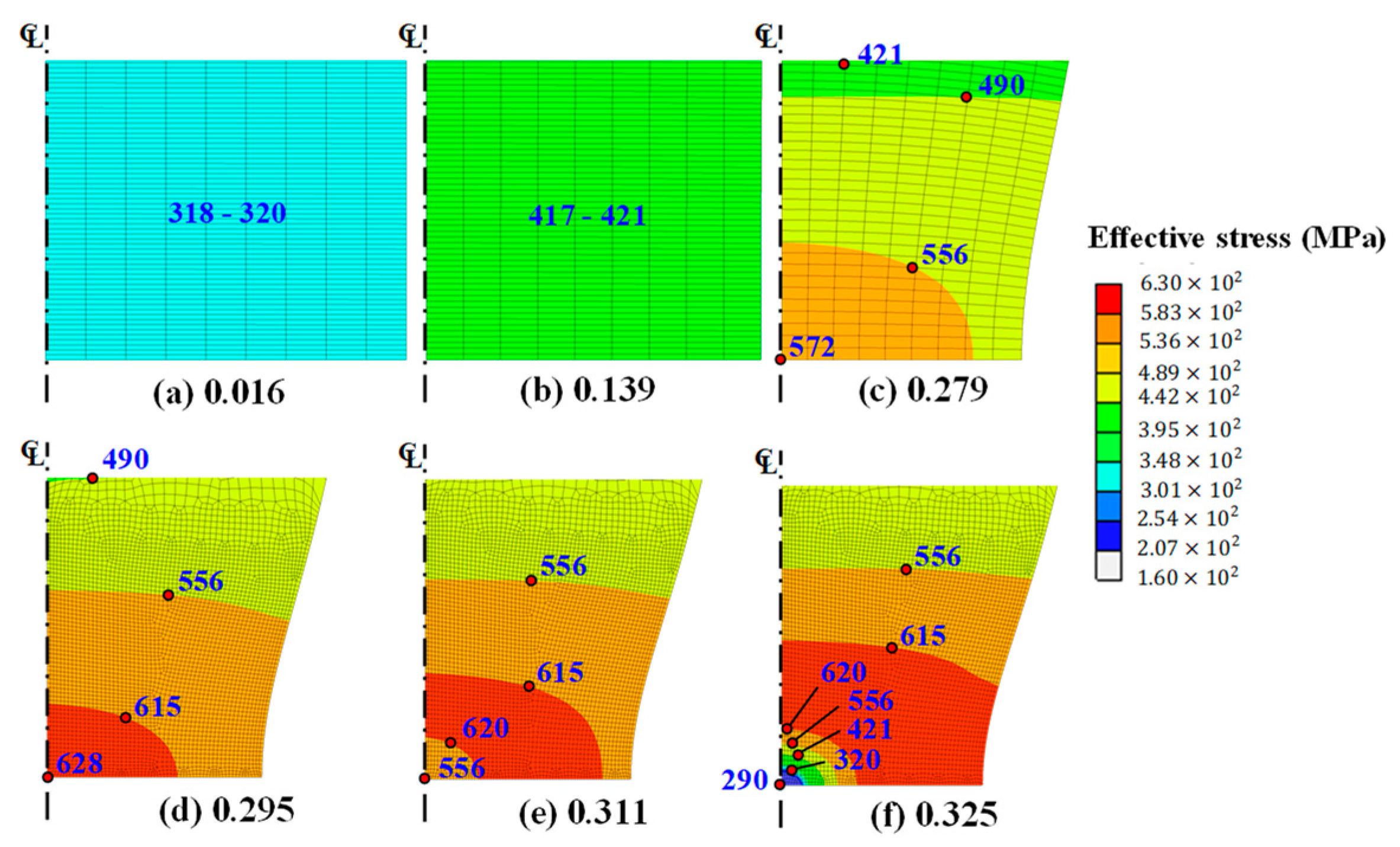
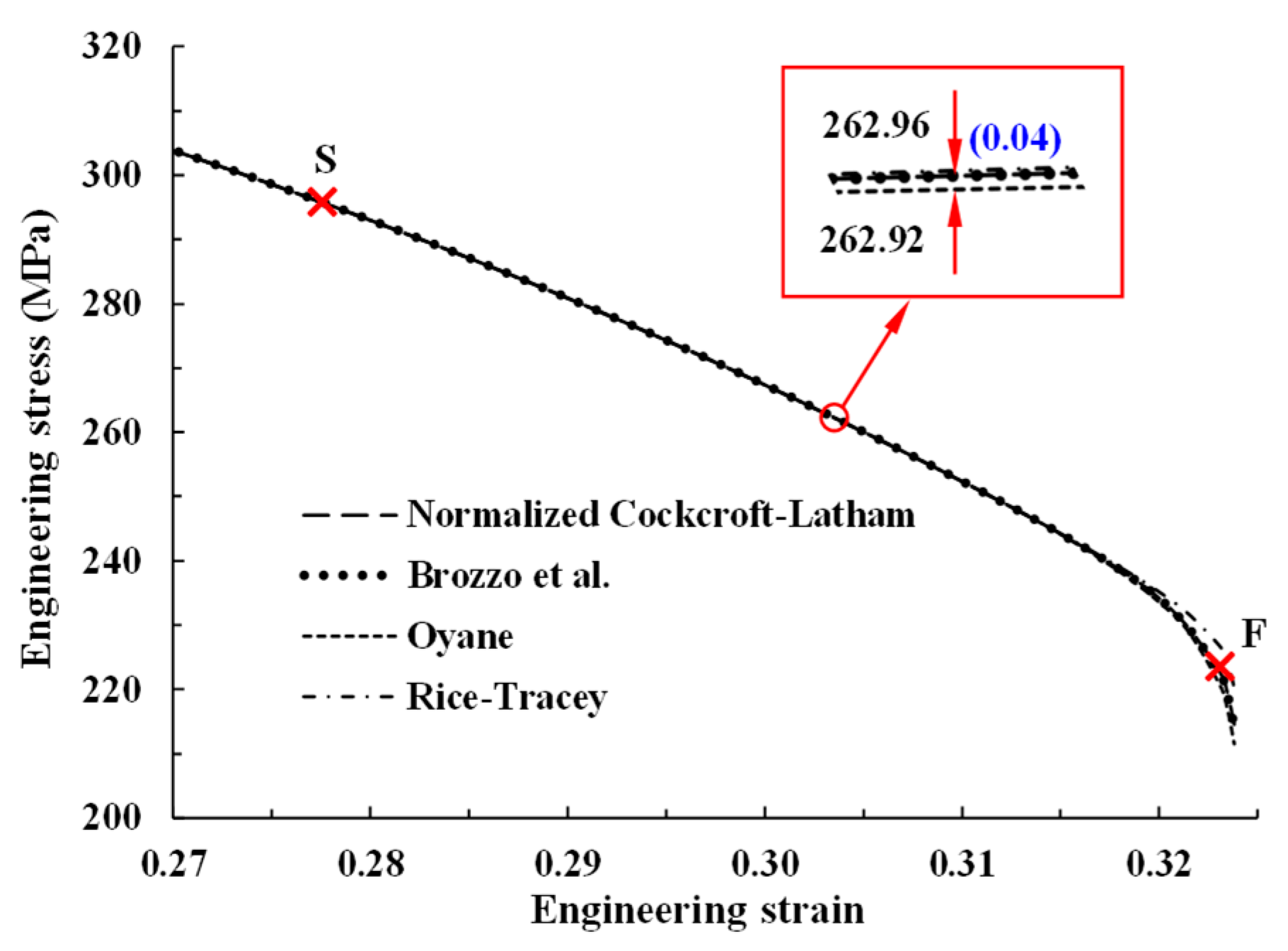

Publisher’s Note: MDPI stays neutral with regard to jurisdictional claims in published maps and institutional affiliations. |
© 2021 by the authors. Licensee MDPI, Basel, Switzerland. This article is an open access article distributed under the terms and conditions of the Creative Commons Attribution (CC BY) license (https://creativecommons.org/licenses/by/4.0/).
Share and Cite
Razali, M.K.; Joun, M.S.; Chung, W.J. A Novel Flow Model of Strain Hardening and Softening for Use in Tensile Testing of a Cylindrical Specimen at Room Temperature. Materials 2021, 14, 4876. https://doi.org/10.3390/ma14174876
Razali MK, Joun MS, Chung WJ. A Novel Flow Model of Strain Hardening and Softening for Use in Tensile Testing of a Cylindrical Specimen at Room Temperature. Materials. 2021; 14(17):4876. https://doi.org/10.3390/ma14174876
Chicago/Turabian StyleRazali, Mohd Kaswandee, Man Soo Joun, and Wan Jin Chung. 2021. "A Novel Flow Model of Strain Hardening and Softening for Use in Tensile Testing of a Cylindrical Specimen at Room Temperature" Materials 14, no. 17: 4876. https://doi.org/10.3390/ma14174876





